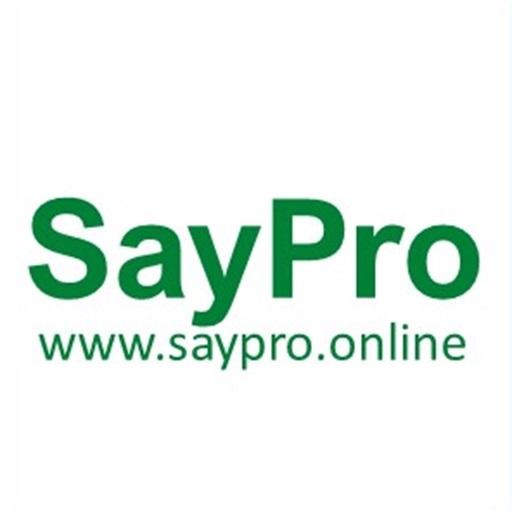Your cart is currently empty!
SayPro Buy Programming Training Material 73429
PURPOSE AND RATIONALE OF THE QUALIFICATION Purpose: This Certificate in Computer Programming teaches software design. This Qualification takes the learner from the inception of the problem, to programming the solution; then to the design of the solution algorithm, proving its correctness, and finally the deployment of the programme coding. Rationale: This Exit-Level Qualification is targeted […]
Description
| PURPOSE AND RATIONALE OF THE QUALIFICATION |
| Purpose:
This Certificate in Computer Programming teaches software design. This Qualification takes the learner from the inception of the problem, to programming the solution; then to the design of the solution algorithm, proving its correctness, and finally the deployment of the programme coding. Rationale: This Exit-Level Qualification is targeted at learners who do not have access to face-to-face tuition (either through lack of mobility, lack of a Further Education and Training college in their area, or full-time work commitments). It will allow unemployed learners to enter the industry, but it also allows those that have worked in the industry for years with no formal Qualification to obtain one; without having to give up their work in order to study. The Qualification prescribes an internship after the final summative assessments, rather than workplace-based training during the programme. |
| LEARNING ASSUMED TO BE IN PLACE AND RECOGNITION OF PRIOR LEARNING |
Candidates accessing this qualification should demonstrate their ability to read, analyse and reflect on study material at least on NQF Level 3. Candidates should be able to demonstrate:
|
| RECOGNISE PREVIOUS LEARNING? |
| Y |
| QUALIFICATION RULES |
| The Qualification is subject-based and consists of a Fundamental, Core and an Elective component. To be awarded the Qualification, learners are required to obtain a minimum of 136 Credits as detailed below. Fundamental: Learning Components; NQF Level; Credit Allocations:
|
| EXIT LEVEL OUTCOMES |
Successful candidates will be able to:
|
| ASSOCIATED ASSESSMENT CRITERIA |
| Integrated Assessment:
Assessment of competence is done through a combination of formative and summative assessment methodologies, tools and procedures, which will not discriminate against learners in an unjust or invalid way. Assessment practices are fair, transparent, valid and reliable. The purpose of assessment is to determine whether a learner has met the outcomes of the Qualification in terms of theory and practice. Integrative techniques are therefore used to assess applied competence. Candidates should be required to demonstrate that they can perform the outcomes with understanding and insight. Assessment should ensure that all Exit Level Outcomes and Critical Cross-Field Outcomes are evaluated. Assessment of the Critical Cross-Field Outcomes should be integrated with the assessment of the Exit-Level Outcomes. The Critical Cross-Field Outcomes are implicit in the learning and assessment programmes are designed to extend and further reflect integration. All subjects include formative assessments, comprising a range of tests, tasks and assignments. A learner’s formative mark counts 40% towards the theory mark of a subject. All subjects have a final examination. The final examination counts 60% towards the theory mark of a subject. In order to achieve the Qualification, a learner must:
|
| INTERNATIONAL COMPARABILITY |
| This Qualification was benchmarked against a similar qualification; Introduction to Computer Programming Diploma, obtainable from the International Correspondence School (ICS) based In the United Kingdom. ICS’s Computer Programming qualification teaches learners the theory behind programming languages, discovering how they are designed for human use but are compiled into machine code before being processed by a computer, and also the syntactic and semantic rules by which programming languages are defined. Learners are taught Visual Basic and C++, two leading programming languages. Learners also explore languages used in website design, focusing on Javascript and the markup language HTML, the predominant language of webpage design. This Qualification compares more than favourably with the syllabus of ICS’s Computer Programming qualification, in that the Qualification also teaches Systems Analysis and Design as well as Information System Management. This benchmarking was appropriate, as both Qualifications can be developed for distance education as well as for face to face learning. |
| ARTICULATION OPTIONS |
| Access to Qualifications on the same level:
Learners who are (have been) registered for the same or another related Qualification on NQF Level 4 will be able to horizontally enter another relevant learning programme on the same level, given the rules of access have been complied with. Such learners will retain credit or exemption for relevant subjects or specific outcomes that have been passed at the previous institution and could enrol for a relevant certificate level programme. |
| MODERATION OPTIONS |
|
| CRITERIA FOR THE REGISTRATION OF ASSESSORS |
For an applicant to register as an assessor for this Qualification, the applicant should:
|
| REREGISTRATION HISTORY |
| As per the SAQA Board decision/s at that time, this qualification was Reregistered in 2012; 2015. |
You must be logged in to post a review.

Reviews
There are no reviews yet.